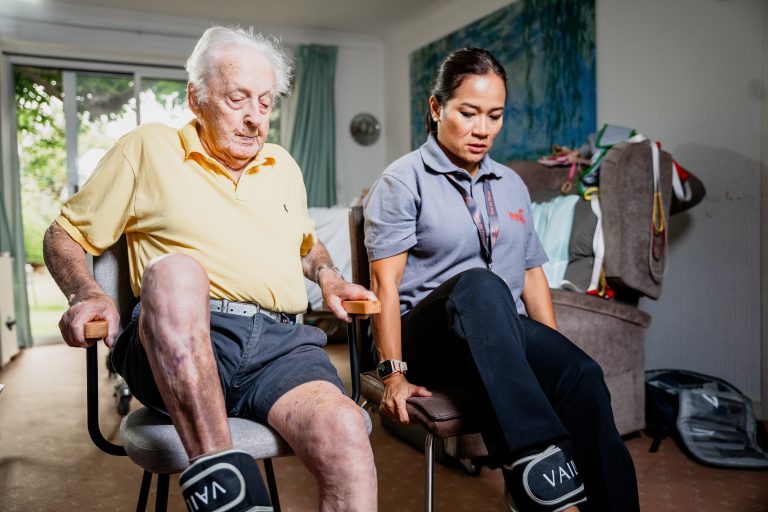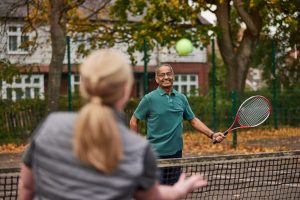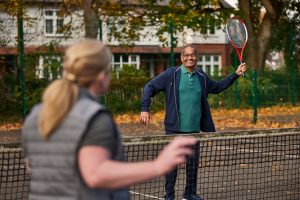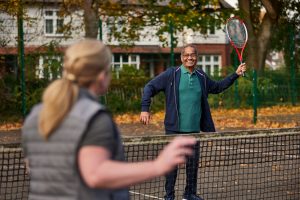Staying active in later life is one of the most powerful ways to maintain independence, boost mood, and improve overall wellbeing. At Walfinch, we believe it is not enough to simply survive, everyone deserves the chance to thrive wherever they are in life. Gentle exercise at home helps seniors stay strong, flexible, and confident, supporting them to continue enjoying daily life.
Whether your loved one lives independently or receives home care assistance, these exercises can be adapted to suit different abilities and fitness levels. With a little encouragement, these exercises can become part of a daily routine to champion health and wellness.
Here are 10 of the best exercises for older people to do safely at home.
1. Seated Leg Lifts
Seated leg lifts are ideal for people with limited mobility.
Here’s how you do it: sit upright in a sturdy chair, lift one leg until it is straight, hold for a few seconds, then lower gently. Alternate legs for 10-15 repetitions.
This strengthens thigh muscles and supports joint stability, making everyday movements like standing or climbing stairs easier. It is also an excellent exercise for anyone receiving home care assistance, who wants to build strength gradually.
2. Arm Raises with Light Weights
Upper body strength is important for tasks such as carrying shopping or lifting household items.
For this exercise, you should: use light dumbbells or water bottles, raise arms to shoulder height, hold briefly, then lower with control. Start with 8-10 repetitions.
If your loved one is supported by our companionship care team, carers can provide encouragement and ensure movements are carried out safely and effectively.
3. Heel-to-Toe Walk
The heel-to-toe walk helps improve balance, ultimately reducing the risk of trips and falls.
Here’s how you do it: place one foot directly in front of the other so the heel touches the toes behind. Take slow steps across the room, using a wall for support if needed.
This simple routine can be added to a care plan for those receiving daily domiciliary care, helping them stay steady on their feet and get the most out of life.
4. Sit-to-Stand Practice
Standing up from a chair can become more difficult with age. Practising sit-to-stand builds strength in the thighs and hips.
Here’s a breakdown of this exercise: start by sitting with arms crossed, then rise slowly before sitting back down. Repeat 8-10 times.
Sitting to standing is one of the most important movements we regularly do, meaning it is crucial to keep our bodies able to do it, for as long as possible. Carers providing personal care services can encourage clients to incorporate this into their routine, building muscle, joint strength and confidence.
You can follow along with this video here, led by Louise Harwood and Amrit Dhaliwal (Walfinch’s Founder and CEO), as part of our Wellness with Walfinch YouTube Series.
5. Shoulder Rolls
Shoulder rolls relieve stiffness, encourage good posture, and increase upper body mobility.
Here’s how to do them safely: gently roll your shoulders forward in a circular motion for 10 repetitions, then roll backwards.
This exercise is particularly useful for seniors spending more time in seated positions, including those receiving live-in care.
6. Ankle Circles
Ankle flexibility supports balance and mobility – and an injured ankle can have a knock-on effect to other parts of the body.
Here’s how you can maintain your ankle health: sit comfortably and rotate one ankle clockwise 10 times, then anticlockwise. Repeat with the other foot.
Carers offering help at home can encourage ankle circles before walking, reducing stiffness and lowering the risk of injury.
7. Wall Push-Ups
Wall push-ups gently build arm, chest, and shoulder strength. These might be a bit trickier for some people, so ensure you have help before attempting.
Here’s how: stand about two feet from a wall, place palms flat, bend elbows to lean towards the wall, then push back. Repeat 8-12 times.
This exercise is a safe alternative to floor push-ups and can be supported by our carers for the elderly at home.
8. Gentle Stretching
Did you know, if your muscles aren’t regularly stretched, they can shorten? That’s why we sometimes experience a tightness in our muscles.
Stretching helps to maintain flexibility, avoid stiffness, and makes your everyday life easier. There are various ways to gently stretch your muscles, such as reaching your arms overhead, leaning side to side, or stretching calves against a wall.
Remember, only stretch to where your body feels comfortable. We’re all different and have natural limitations – so it’s important to stretch safely.
Stretching is often recommended for those recovering from illness or surgery, and it can be incorporated into convalescent care at home.
9. Marching in Place
Marching boosts circulation, stamina, and balance.
To do this, you should lift your knees slightly higher than your usual walking pace and swing your arms gently. This can be done with the support of a chair for added safety.
At Walfinch, we aim to promote ten minutes of activity for every visit one hour or longer. Our carers often use marching or similar exercises as an accessible way to stay active.
10. Breathing Exercises
Deep breathing is vital for relaxation and lung capacity, but it often goes missing.
For this, you can sit comfortably in a chair, inhale deeply through the nose, hold, then exhale slowly through the mouth. Repeat 5-10 times.
Breathing exercises are especially valuable for those living with conditions such as COPD, anxiety, or recovering after hospital discharge. They are frequently used in our care assistance services.
Why Exercise Matters for Seniors
Regular physical activity offers more than just physical benefits. It can also:
- Reduce the risk of falls and injury.
- Improve memory and concentration.
- Enhance emotional wellbeing, reducing feelings of loneliness.
- Increase independence in everyday life.
At Walfinch, we’ve seen first-hand how even small steps can make a big difference. Whether it’s a short walk in the garden or a series of simple stretches, activity can help clients to feel more energised and positive.
Staying Safe While Exercising
Safety should always be the priority. If doing these exercises, you should:
- Wear sturdy shoes with good grip.
- Keep water nearby to stay hydrated.
- Avoid overexertion by starting slow and increasing gradually.
- Exercise in well-lit, clutter-free spaces.
- Stop immediately if you experience pain, dizziness, or shortness of breath.
Our home care services are designed to provide support, reassurance, and tailored assistance, ensuring you have the opportunities to thrive, every day.
How Walfinch Encourages Active Living
Our ethos is simple: it is always Time to Thrive. Exercise is one way to ensure a person’s later years are lived to the fullest. Our carers are trained to encourage movement as part of everyday routines, whether through structured exercises or gentle activities such as walking, gardening, or dancing to a favourite song.
We provide a wide range of services, from companionship care to respite care, ensuring families and clients have the right support, whatever their individual situation.
If your loved one could benefit from gentle encouragement to stay active, our home care expertise could make a world of difference. For extra inspiration, you can explore our Wellness with Walfinch video series on YouTube, where we share practical tips and simple exercises to help you or your loved one stay healthier and happier, at home.
Final Thought
Exercise at home doesn’t need to be complicated. From ankle circles to sit-to-stand practice, these 10 exercises help seniors build strength, balance, and confidence. With the right guidance and encouragement, daily activity can transform wellbeing, helping older adults enjoy life’s next chapter.





